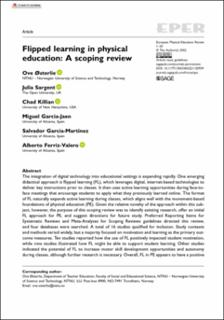| dc.contributor.author | Østerlie, Ove | |
| dc.contributor.author | Sargent, Julia | |
| dc.contributor.author | Killian, Chad | |
| dc.contributor.author | García-Jaén, Miguel | |
| dc.contributor.author | García-Martínez, Salvador | |
| dc.contributor.author | Ferriz-Valero, Alberto | |
| dc.date.accessioned | 2023-02-21T08:47:57Z | |
| dc.date.available | 2023-02-21T08:47:57Z | |
| dc.date.created | 2022-09-15T12:45:59Z | |
| dc.date.issued | 2023 | |
| dc.identifier.citation | European Physical Education Review. 2023, 29 (1), 125-144. | en_US |
| dc.identifier.issn | 1356-336X | |
| dc.identifier.uri | https://hdl.handle.net/11250/3052595 | |
| dc.description.abstract | The integration of digital technology into educational settings is expanding rapidly. One emerging didactical approach is flipped learning (FL), which leverages digital, internet-based technologies to deliver key instructions prior to classes. It then uses active learning opportunities during face-to-face meetings that encourage students to apply what they previously learned online. The format of FL naturally expands active learning during classes, which aligns well with the movement-based foundations of physical education (PE). Given the relative novelty of the approach within this subject, however, the purpose of this scoping review was to identify existing research, offer an initial FL approach for PE, and suggest directions for future study. Preferred Reporting Items for Systematic Reviews and Meta-Analyses for Scoping Reviews guidelines directed this review, and four databases were searched. A total of 16 studies qualified for inclusion. Study contexts and methods varied widely, but a majority focused on motivation and learning as the primary outcome measures. Ten studies reported how the use of FL positively impacted student motivation, while nine studies illustrated how FL might be able to support student learning. Other studies indicated the potential of FL to increase motor skill development opportunities and autonomy during classes, although further research is necessary. Overall, FL in PE appears to have a positive impact on student variables. Research on the design and implementation of both the digital and in-class instructional components will be necessary to guide best practice more appropriately. Further, rigorous research is also necessary to extend understanding of the influence of FL on student outcomes. | en_US |
| dc.language.iso | eng | en_US |
| dc.publisher | Sage Publishing | en_US |
| dc.rights | Navngivelse-Ikkekommersiell 4.0 Internasjonal | * |
| dc.rights.uri | http://creativecommons.org/licenses/by-nc/4.0/deed.no | * |
| dc.title | Flipped learning in physical education: A scoping review | en_US |
| dc.title.alternative | Flipped learning in physical education: A scoping review | en_US |
| dc.type | Peer reviewed | en_US |
| dc.type | Journal article | en_US |
| dc.description.version | publishedVersion | en_US |
| dc.source.pagenumber | 125-144 | en_US |
| dc.source.volume | 29 | en_US |
| dc.source.journal | European Physical Education Review | en_US |
| dc.source.issue | 1 | en_US |
| dc.identifier.doi | 10.1177/1356336X221120939 | |
| dc.identifier.cristin | 2052013 | |
| cristin.ispublished | true | |
| cristin.fulltext | original | |
| cristin.fulltext | original | |
| cristin.qualitycode | 1 | |

